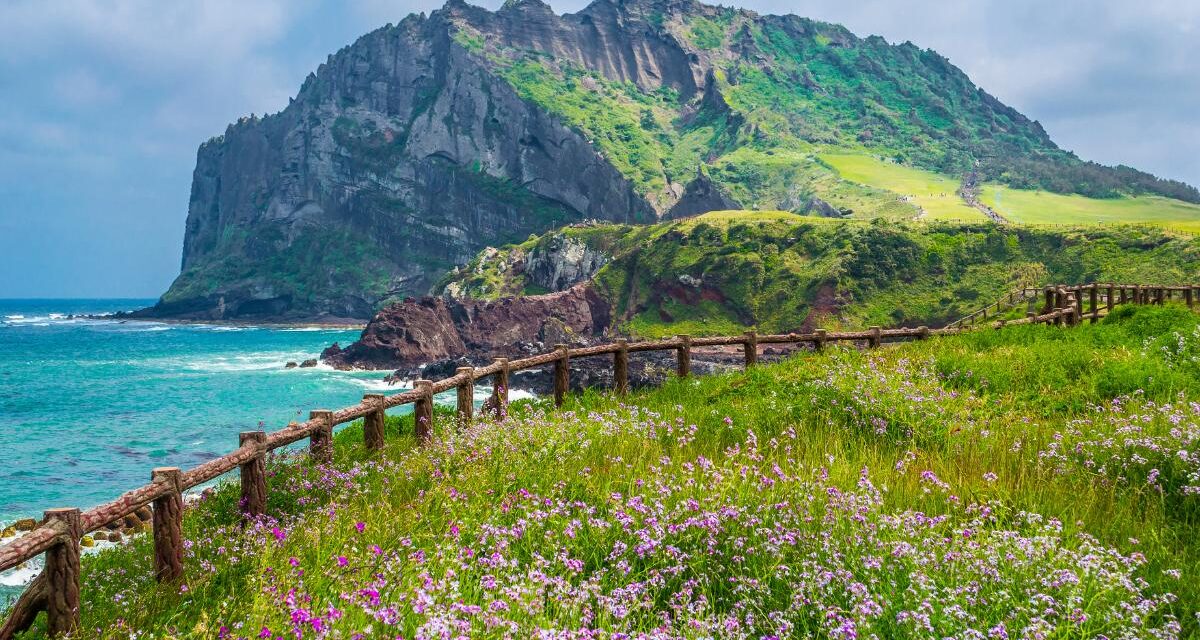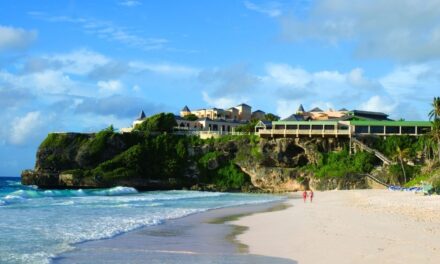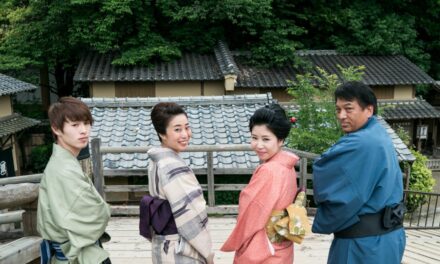Some call it ‘The Island of the Gods’. Others refer to it as a true natural wonder of the world.
Regardless of how its described, there is no doubt Jeju Island is one of the most remarkable places on Earth.
Located in the Korean Strait in South Korea, Jeju Island was formed about 2 million years ago through volcanic activity.
Today, the island boasts of a distinct natural landscape with unique flora and fauna.
It’s volcanic mountains, lava tubes and natural ecosystems have UNESCO World Heritage Site and Global Geopark recognition.
In short, a visit to Jeju Island should be in the bucket list of all travel enthusiasts.
Most Trusted Jeju Island Travel Resources:
For experiences, day tours, sightseeing and more: Visit Viator Jeju Island
For the best hotel and resort deals: Visit Booking.com Jeju Island
Page Contents
- How do you experience the best of Jeju Island?
- The top 20 things to do in Jeju Island
- 1) Hallasan Mountain Natural Reserve
- 2) Geomunoreum Lava Tube System – Manjanggul caves
- 3) Seongsan Ilchulbong Tuff Cone – Sunrise Peak
- 4) Hyeopjae Beach
- 5) Hamdeok Beach
- 6) Iho Tewoo Beach
- 7) Dol Hareubang – Jeju Stone Park
- 8) Experience Jeju Coast with Jeju Olle Trails
- 9) Jeongbang Waterfalls
- 10) Cheonjiyeon Waterfalls
- 11) Jusangjeolli Cliff
- 12) Jeju Food Tour
- 13) Dongmun Market
- 14) Sangumburi Crater
- 15) Seongeup Folk Village
- 16) Jeju Museum Tour
- 17) Seogwipo Walking Tour
- 18) Jeju City Walking Tour
- 19) Learn about Haenyeo Divers
- 20) Hallim Park
- Bonus
- Final thoughts
How do you experience the best of Jeju Island?
To truly experience the essence of Jeju Island, you have to appreciate and recognize its unique culture and natural wonders.
Therefore, you need to indulge in activities that allow you to be part of the beautiful local culture. You need to do things that help you explore all the natural wonders of Jeju Island.
Do remember, Jeju Island is known for its distinct culture that is slightly different from the rest of South Korea.
At the same time, places like Jeju city, the capital of Jeju Island is a fast-developing, modern city.
As a tourist, you need to experience the heritage, culture, natural marvels and changing face of Jeju Island. This is the only way to get the best of your trip and understand this unique part of the world.
The top 20 things to do in Jeju Island
Jeju Island is an oval shaped island with the majestic Mt. Hallasan situated right at the center.
There are several attractions spread throughout Jeju Island in all directions.
Interestingly, there are only two cities in Jeju Island that cover the entire northern and southern halves.
Jeju City, the capital covers the northern half while Seogwipo City covers the southern half of Jeju Island.
With a length of about 73 kms and width of about 31 kms, the entire island is easily accessible via public and private transport.
Keeping that in mind, I am listing the absolute best things to do in Jeju Island. I have ensured to cover the main natural landmarks, cultural activities, heritage sites and more.
1) Hallasan Mountain Natural Reserve
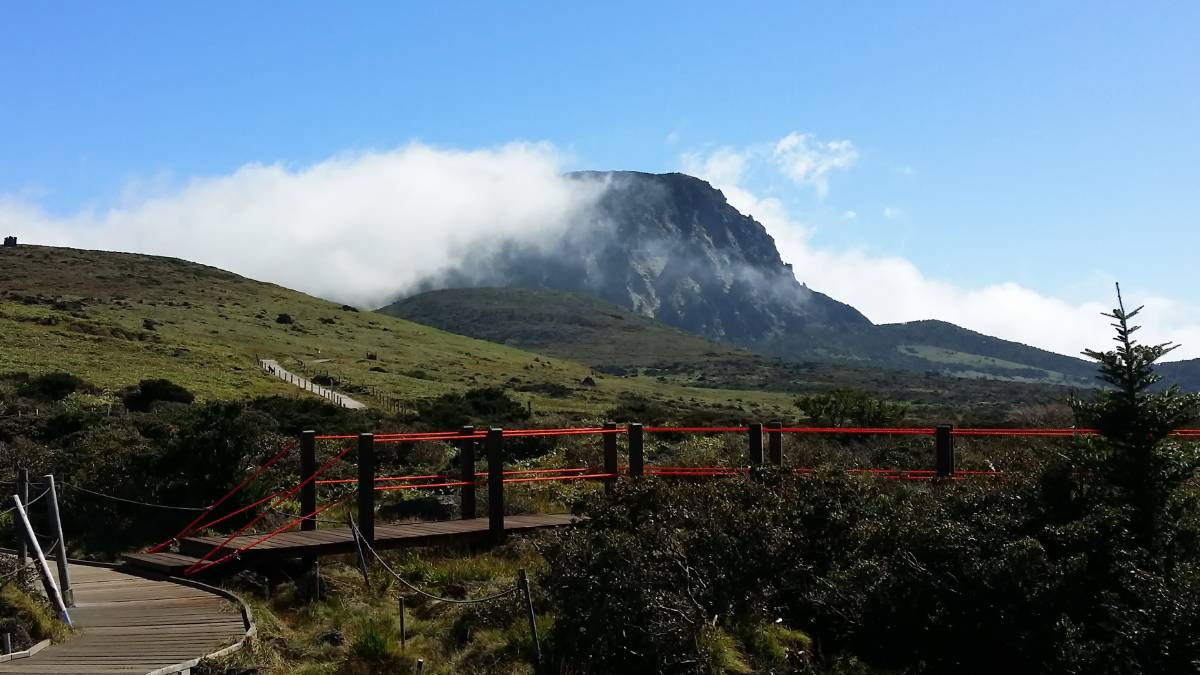
The majestic Mt Hallasan is the absolute core of Jeju Island.
It is the one place that you absolutely must visit.
Think of it this way. If you visited Paris, visiting The Eiffel Tower would be foremost on your to-do list.
Similarly, when in Jeju Island, Mt Hallasan is the most notable tourist attraction.
The only difference being the former is a human-made wonder while Mt Hallasan is a natural wonder of the world.
Estimated to be about 25,000 years old, Mt Hallasan at its peak is the highest point in entire South Korea.
While its imposing 1,947 metres height is quite a sight, the area around the mountain is simply awe-inspiring.
The areas surrounding it is known as the Hallasan Mountain Natural Reserve.
This natural reserve with the Hallasan National Park is one of the most beautiful places on earth.
To make the most of Hallasan Mountain, you have two choices.
First, you could take a taxi or drive to Hallasan National Park. From here, you could walk around the many nature trails and admire this enchanting place.
Second, you could choose to hike to the summit.
Hiking Mt Hallasan is probably the best activity in Jeju Island. It is completely safe but it does take a long time.
Expect 4 to 5 hours one way depending upon your fitness and speed. Once you are on top, there is nothing in entire South Korea that is more mesmerising.
Apart from the panoramic views, you will experience distinct flora and fauna not found in other locations.
Hiking Mt Hallasan is a full day activity so do keep that in mind.
Of course, simply walking around Hallasan National Park is also an enthralling activity. Its beauty, uniqueness, wildlife, geology and biodiversity are absolutely spellbinding.
I suggest to spend as much time as possible at Hallasan Mountain Natural Reserve.
You will experience a great UNESCO World Heritage Site and understand why locals refer to it as a spirit mountain.
2) Geomunoreum Lava Tube System – Manjanggul caves
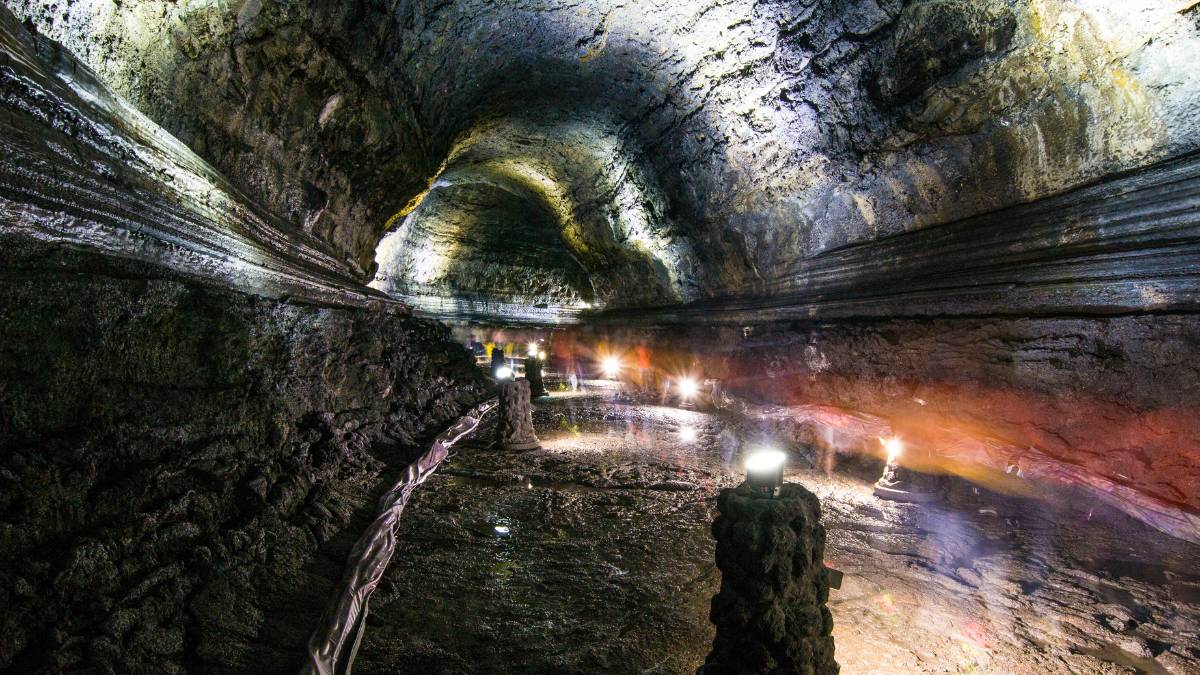
The Jeju Volcanic Island and Lava Tubes are a UNESCO World Heritage Site that are of incredible importance.
These lava tube systems are hundreds of thousands of years old.
They were formed as the lava from volcanic eruptions flowed from parts of the island to the coast.
The Geomunoreum Lava Tube System in Jeju Island is considered as one of the best-preserved systems. You can access these lava tube systems from various points such as the famous Manjanggul caves.
I am trying not to get into a complete geology lesson right now. You just need to imagine how rich the roofs, floors and walls of these lava systems are in natural history.
Studying some of the rock formations and other features here can unlock some of Earth’s formative mysteries.
Exploring the Geomunoreum Lava Tube System allows you to walk through extraordinary geological history of our planet.
The entire lava systems with their natural caves, paths and other characteristics are beautiful as well as enchanting.
The Geomunoreum Lava Tube System and Manjanggul caves can be easily accommodated during a full day tour of Jeju Island.
3) Seongsan Ilchulbong Tuff Cone – Sunrise Peak
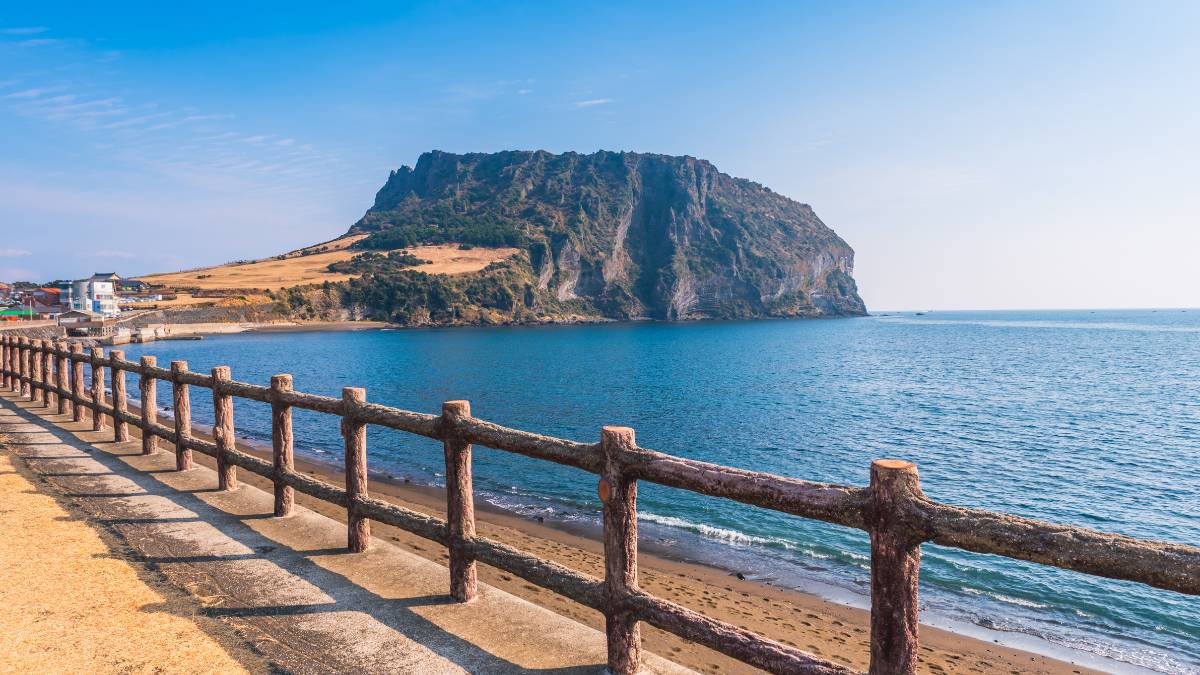
The Seongsan Ilchulbong Tuff Cone is the third UNESCO World Heritage Site in Jeju Island.
This volcanic cone of breathtaking beauty was formed about 5000 years ago due to hydrovolcanic eruptions.
Seongsan Ilchulbong stands as a majestic figure at the middle of the ocean surrounded by superb panoramic views.
Tourists can visit Seongsan Ilchulbong and explore the area all around the tuff cone.
If you are up for it, you can even climb to the top using the specially built stairs. It is about an hour’s climb to the top.
Making it to the top is completely worth the effort. The views are simply awe-inspiring but you also get to see the crater in between the volcanic cone.
This itself is a thrill and the greenery, fauna and flora are out of this world.
Seongsan Ilchulbong Tuff Cone is also referred to as Sunrise Peak by the locals.
This is because it is one of the best places in Jeju Island to view the sunrise.
If you can get to Seongsan Ilchulbong Tuff Cone at dawn, you will be treated to a special sunrise.
Seongsan Ilchulbong Tuff Cone is a must-visit place in Jeju Island with its geological importance and extraordinary natural beauty.
4) Hyeopjae Beach
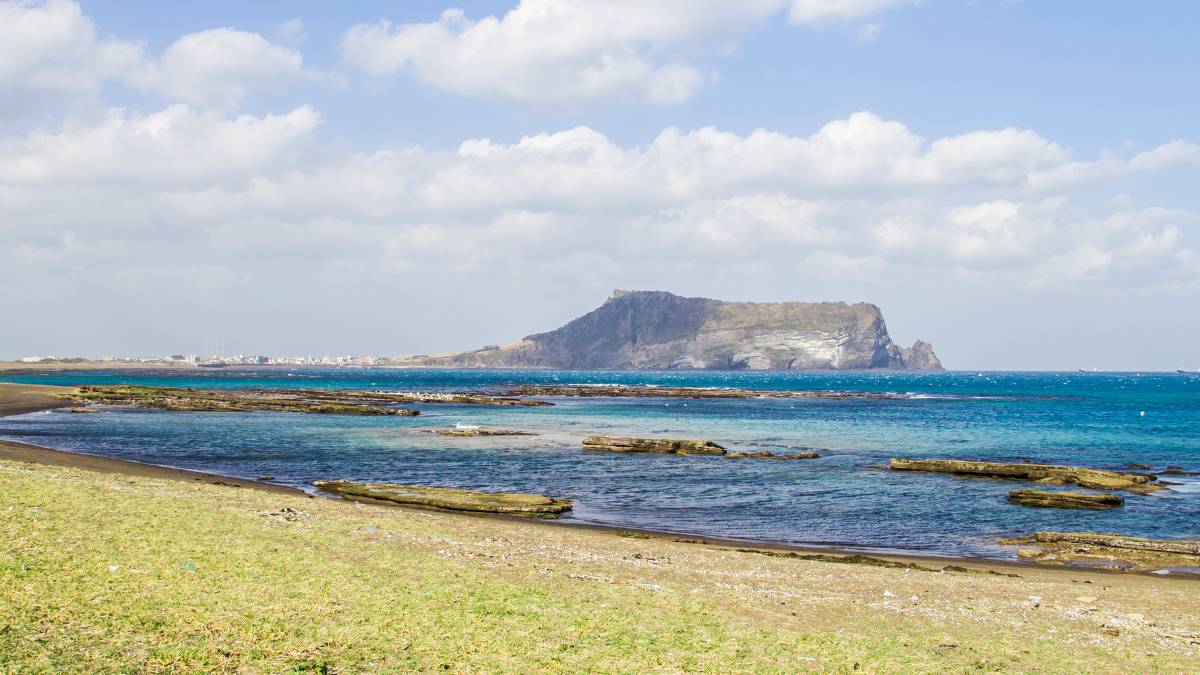
It is no surprise that Jeju Island has some of the best beaches in Far East Asia.
Considering the island was formed due to oceanic volcanic eruptions, its coastline is quite sublime.
Most locals consider Hyeopjae Beach as one of the most beautiful beaches in Jeju Island.
Hyeopjae Beach is located in the western region of Jeju Island. It is highly sought-after for its crystal-clear turquoise waters, silky bright sand and beautiful panoramic views.
At a distance, you can view the Biyanglo Island. You can walk around the shallow waters that initially go up to 1.2 meters in depth.
What I particularly like about Hyeopjae Beach is that it is a family destination.
The entire beach is lined with several amenities that include changing rooms, shower areas, restrooms, restaurants etc.
There are several attractions nearby as well including the popular Hallim Park.
You will have a great time at Hyeopjae Beach and can spend hours at the beach plus exploring nearby landmarks.
5) Hamdeok Beach
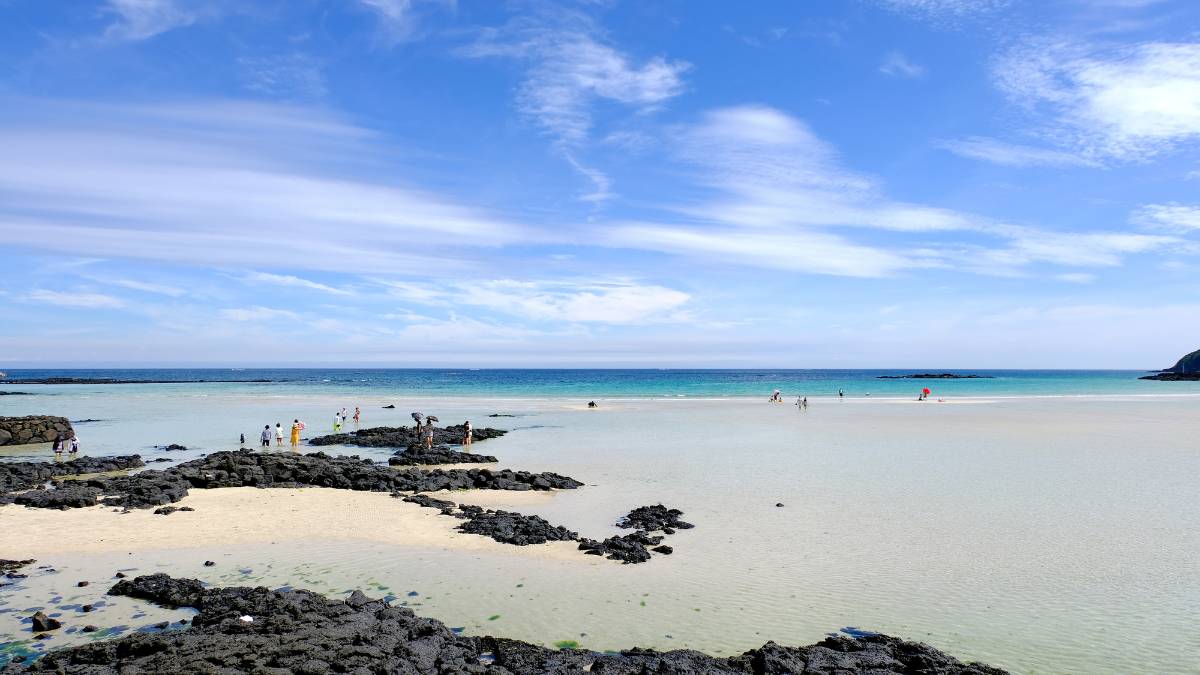
Hamdeok Beach is the closest beach to Jeju City.
It is located in the northern region of Jeju Island.
If you want to swim in the ocean waters in Jeju Island, then Hamdeok Beach is the best by far.
This is thanks to its super calm crystal-clear waters that have the ideal swimming conditions.
With natural sand bars and rock pools, Hamdeok Beach is a great place for families with kids.
Of course, if you want to be away from the crowd, Hamdeok Beach is large enough to find secluded spots.
The amenities around the beach are great and you have nice eating places to relax and enjoy Korean cuisine.
For water sports enthusiasts, Hamdeok Beach has a decent range of options including motorboats, kayaks, banana boats etc.
Overall, Hamdeok Beach is one of the best and safest family beaches in Jeju Island.
6) Iho Tewoo Beach
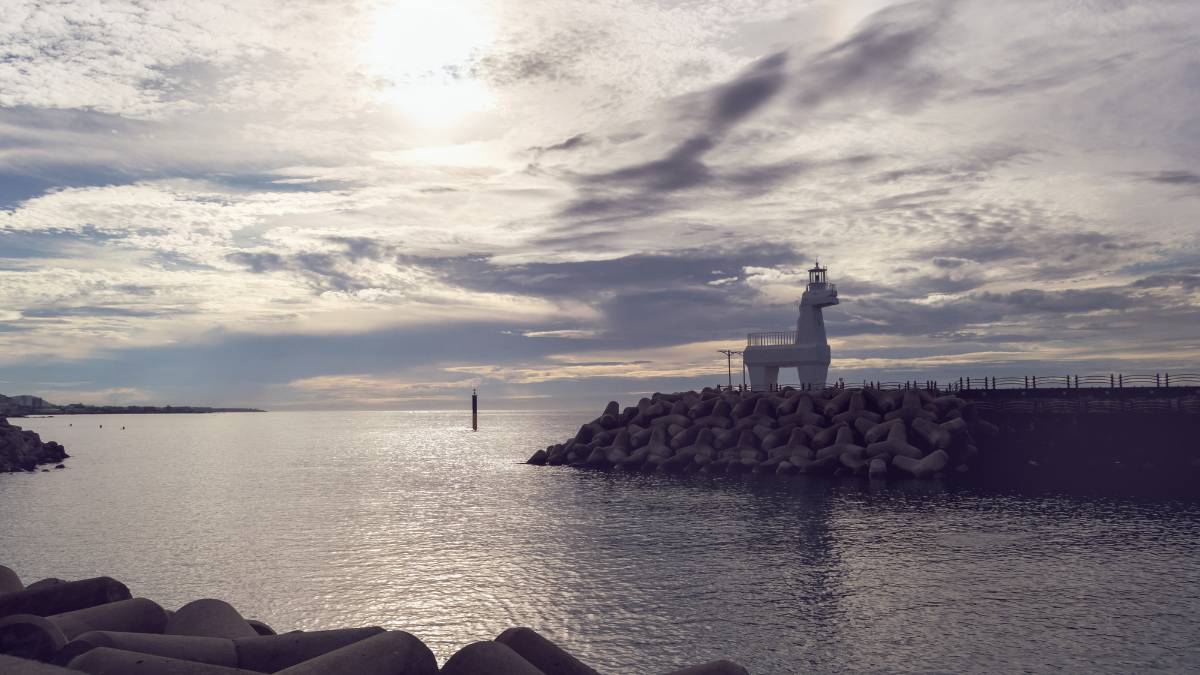
The third and final beach I am featuring on my list is Iho Tewoo Beach.
This beach is famous for two reasons.
First, thanks to the two unique lighthouses that are shaped as a red and white horse respectively.
Second, a section of the coastal walk area is part of the famous Olle Trail in Jeju Island.
I will cover more on the Olle Trail a little later in the article.
However, it is a beautiful walk near Iho Tewoo Beach with lots to do nearby.
I do believe Hyeopjae Beach and Hamdeok Beach are more naturally beautiful.
Nevertheless, Iho Tewoo Beach has its own charm and has a more city beach vibe to it.
You can spend a lovely time at the beach and walk around its famous spots. Once done, you can enter town and have a super time going around its popular spots.
7) Dol Hareubang – Jeju Stone Park
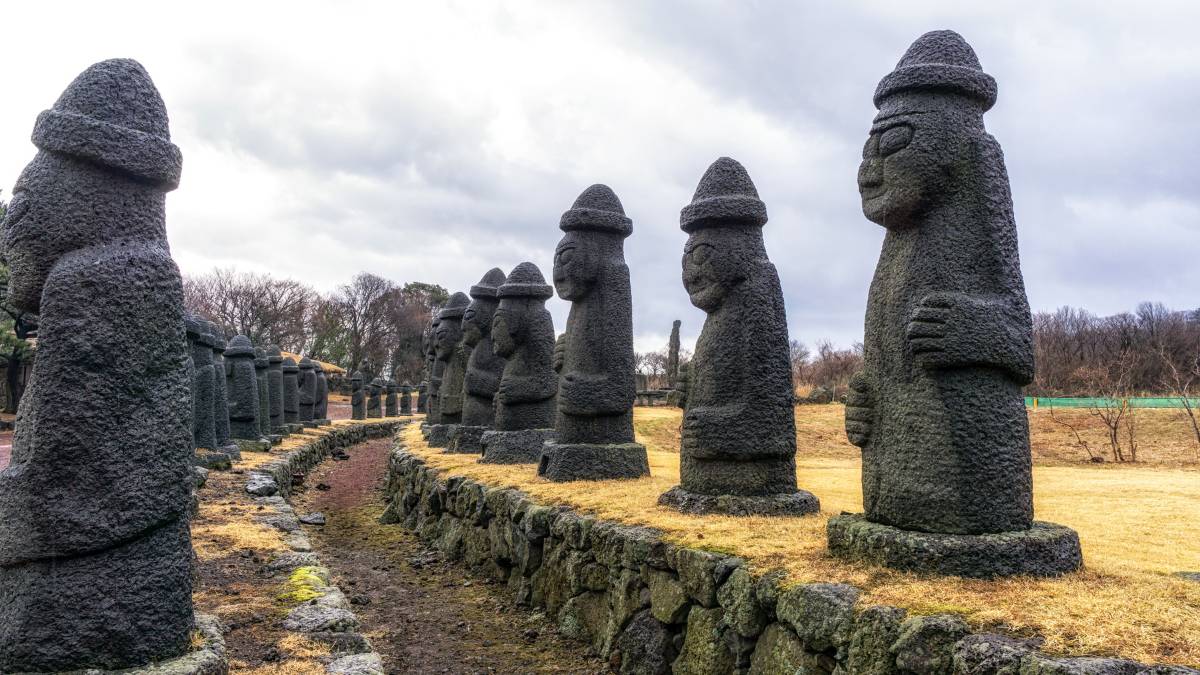
Dol Hareubang are stone statues found all around Jeju Island and believed to be Gods of both protection and fertility.
The literal translation though of Dol Hareubang is ‘Old Grandfather’. The statues do resemble this and have a particular stance.
They are quite an interesting sight. Your visit to Jeju Island is not complete till you have spotted one of these fascinating sculptures.
All of these statues have been carved from volcanic rocks and are well over 250 years old.
The Dol Hareubang can be seen at multiple places in Jeju Island.
However, I feel the two best places are Jeju Stone Park and Bukchon Dol Hareubang Park.
Jeju Stone Park in particular is a popular spot with tourists. This is a huge area that has everything related to volcanic stone of Jeju Island.
It is a natural museum and park combined. You get to see the Dol Hareubang and various other stone work of Jeju Island across multiple sections.
You can easily spend a few hours going through all of what Jeju Stone Park has to offer.
The other place to see Dol Hareubang statues is the Bukchon Dol Hareubang Park.
There are 48 of these statues at the park. Tourists especially like the promenade and garden at the location.
You can walk at a leisurely pace taking in all of the sights of the Dol Hareubang and scenic views.
8) Experience Jeju Coast with Jeju Olle Trails
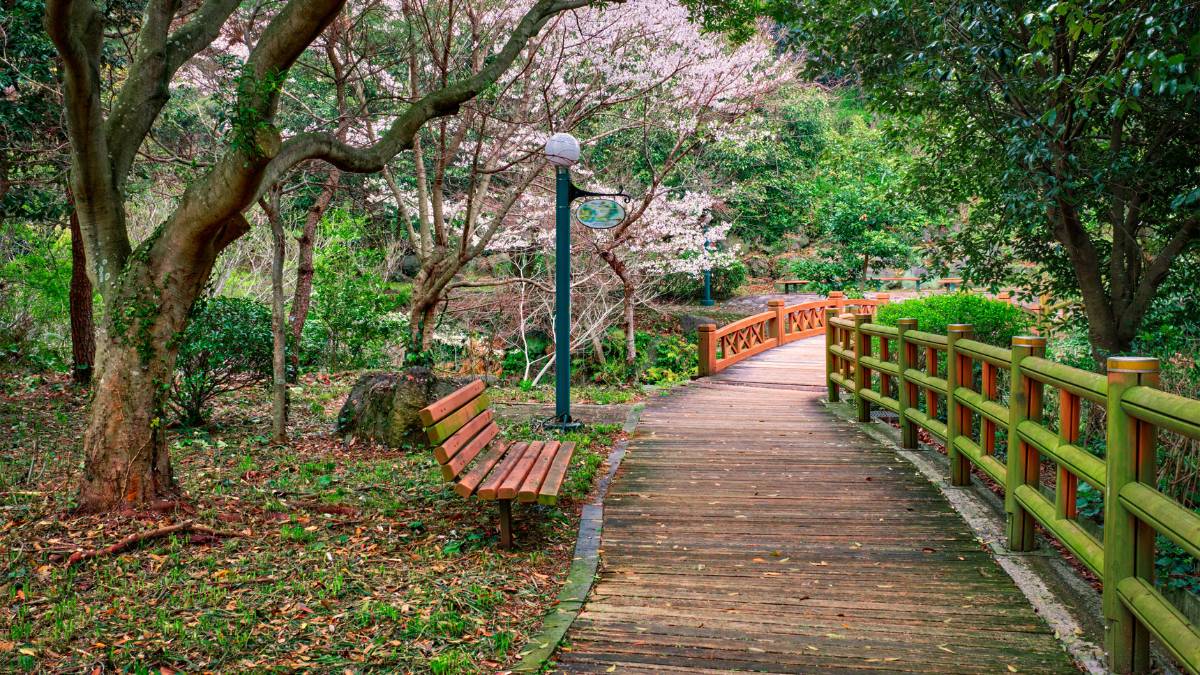
The entire Jeju Coast is simply breathtaking, shaped by thousands of years of volcanic activity.
To not just preserve the coast but to provide a great view of it, the Jeju Olle Trails were formed.
The Jeju Olle Trails goes all around Jeju Island with a total distance of approximately 437 kms.
There are 26 sections at the trail. Each of them has their own distinct characteristics, mesmerising views and difficulty level.
During your stay at Jeju Island, you must try at least a couple of these trails that form Jeju Olle Trails.
They are usually numbered as route 1, route 2 and so on. There are 21 main routes and 6 sub-routes.
Some tourists actually manage to cover all of the routes thereby covering the entire Jeju coast.
Most feel Jeju Olle Trails is part of the top 10 best coastal walkways in the entire world.
To choose the route for yourself, I suggest to select as per where you are staying in Jeju Island.
Your hotel will know the nearest route and where you can get in and get off.
9) Jeongbang Waterfalls
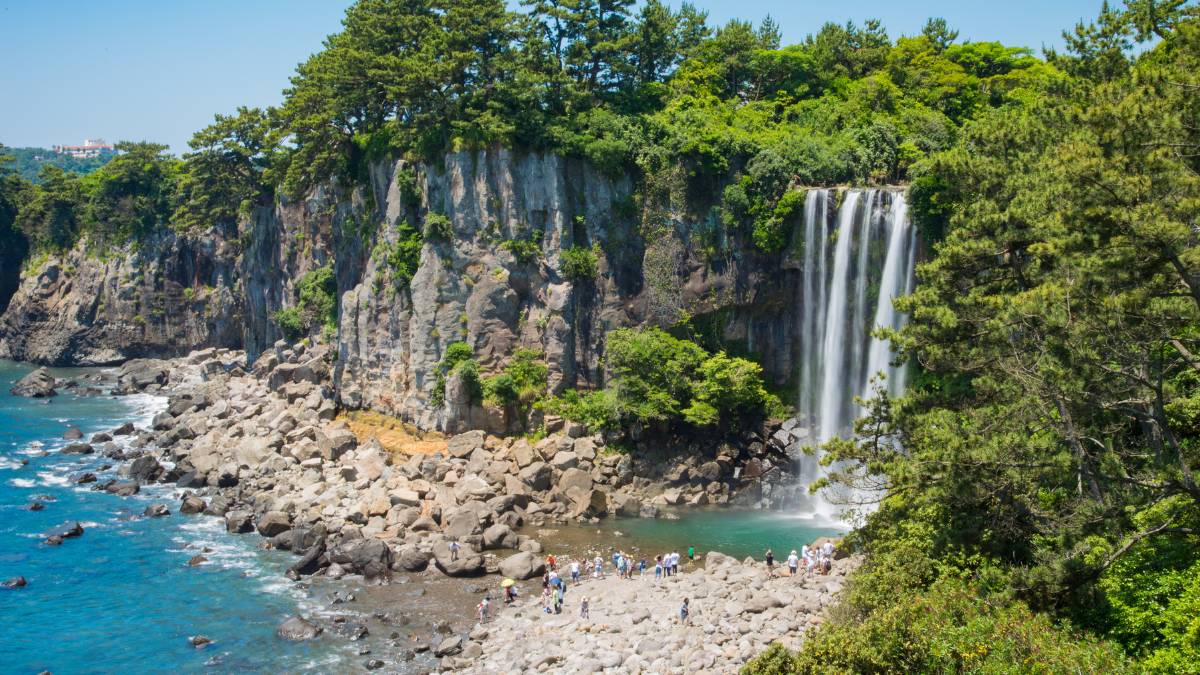
Jeju Island has some really famous waterfalls that are all quite stunning.
Jeongbang Waterfalls is probably the most famous of them all and extremely popular with tourists.
This is because Jeongbang Waterfalls is one of the few waterfalls in the world that directly flows into the ocean.
It is a spectacular sight especially if the waterflow is strong after rains.
Located in the southern coast of Jeju Island, you can take either a bus or taxi to reach Jeongbang Waterfalls.
There is a 10-minute walk to get to the actual waterfall. Some hike down for about 20 minutes to the base of the falls for an even better view.
The entire place is quite scenic with forest and ocean views all around.
Jeongbang Waterfalls is about 75 feet high and 26 feet wide.
10) Cheonjiyeon Waterfalls
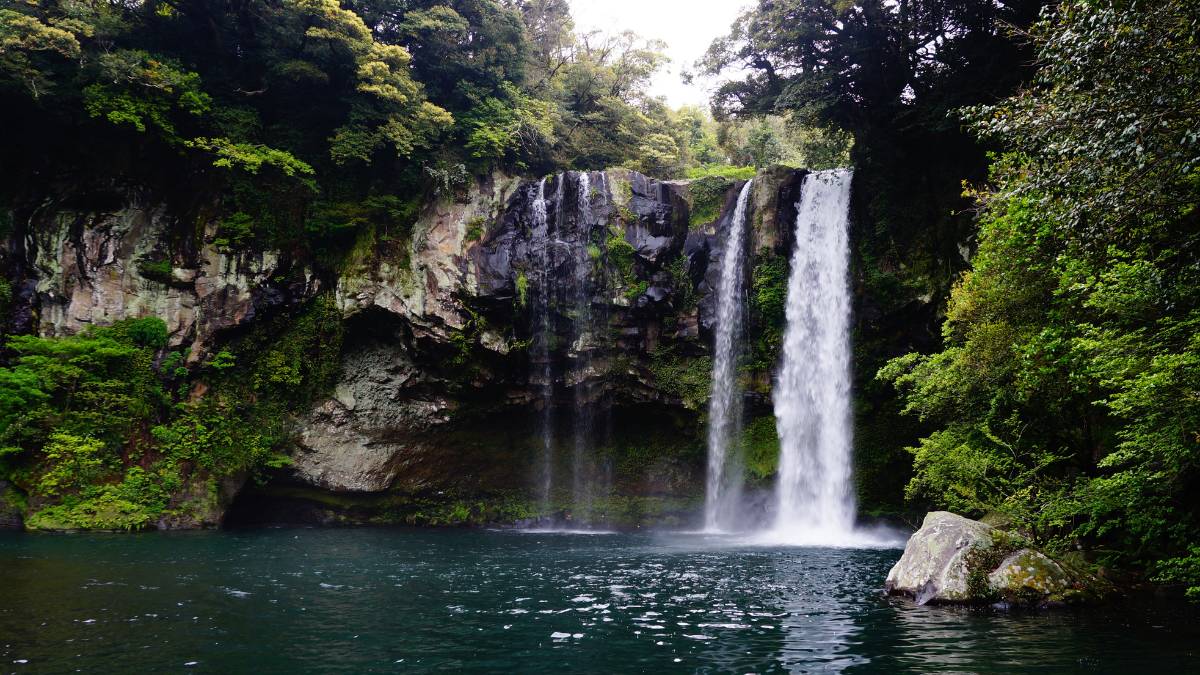
Cheonjiyeon Waterfalls is the other famous waterfall of Jeju Island after Jeongbang Waterfalls.
Although not as dramatic, it is a beautiful waterfall with nature-rich surroundings.
The trail to reach Cheonjiyeon Waterfalls is quite lovely as well.
What is interesting is that Cheonjiyeon Waterfalls seems to be more popular at night than during the day.
This is because the falls get illuminated revealing a ‘hidden face’ amidst the rocks.
The biodiversity around Cheonjiyeon Waterfalls is another aspect that tourists appreciate about the location.
Visiting any waterfall in Jeju Island is quite scenic, nature rich and is a chance to learn about Korean culture.
Each of the falls including Cheonjiyeon Waterfalls is extremely well maintained with good amenities nearby.
Cheonjiyeon Waterfalls is about 72 feet high and 39 feet wide.
11) Jusangjeolli Cliff
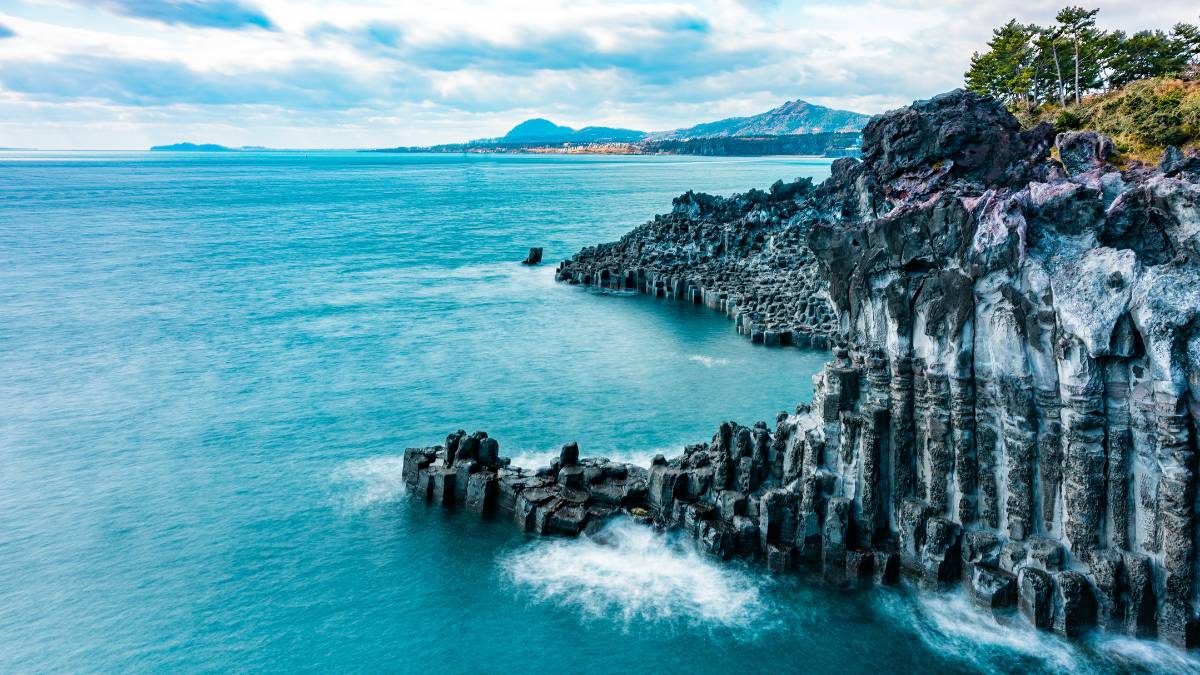
Jusangjeolli Cliff is the most famous cliff in Jeju Island thanks to its hexagonal shape and surreal natural beauty.
Located at south coast Jeju Island, Jusangjeolli Cliff was formed after Mount Hallasan volcano erupted thousands of years ago.
The lava from the eruption flowed towards the Jungmun sea to form Jusangjeolli Cliff.
Visitors to the cliffs are mesmerised by the perfectly shaped geometrical hexagonal rocks all along the coast.
It completely looks like you are in a sci-fi movie exploring another planet.
Both the Jusangjeolli Cliff along with the ocean below make for a setting of unparallel beauty.
A walk along the rugged coastal path to view Jusangjeolli Cliff is a great experience. There are strategic points for getting the best view.
Do remain cautious though and do not get too near the edge due to the steep vertical drop below.
12) Jeju Food Tour
Jeju Island is known for having distinct cultural characteristics as compared to rest of South Korea.
This includes its cuisine that has evolved over thousands of years.
If you want to experience Jeju Island to its fullest, you must try some of its famous dishes.
Some of the most famous dishes of Jeju Island are:
- Black pork – BBQ or Grilled
- Galchi jorim (Hairtail fish)
- Fresh Abalone
- Seafood ramen or noodles
- Streetside raw seafood platter – sold by Haenyeo
- Pheasant broth with buckwheat noodles
- Omegi Tteok (Korean rice cake)
The way of preparing the dishes is also quite unique to Jeju Island.
I suggest to either walk around and try dishes from local restaurants or opt for sightseeing tours that include food.
BBQ black pork is especially famous in Jeju Island. Many all-day sightseeing tours include a visit to popular Jeju Black Pork BBQ restaurants.
13) Dongmun Market
Another brilliant way to experience Jeju culture is to visit one of its traditional markets.
Located in Jeju City itself, this is one of the oldest and most traditional indoor markets in Jeju Island.
It is a thrill to just walk around and experience all the sights and sounds.
You can get the best of fresh seafood, Jeju meat, snacks, fruits and other items in the market.
It is one of the best places to sample Jeju food as you walk around.
Dongmun Market is great for souvenirs and quick snacks that you can munch on anytime.
The entire market is very well organized and extremely vibrant. Regardless of whether you love visiting markets or not, do check out Dongmun Market. It will help you get a bit of an insight on life in Jeju Island.
14) Sangumburi Crater
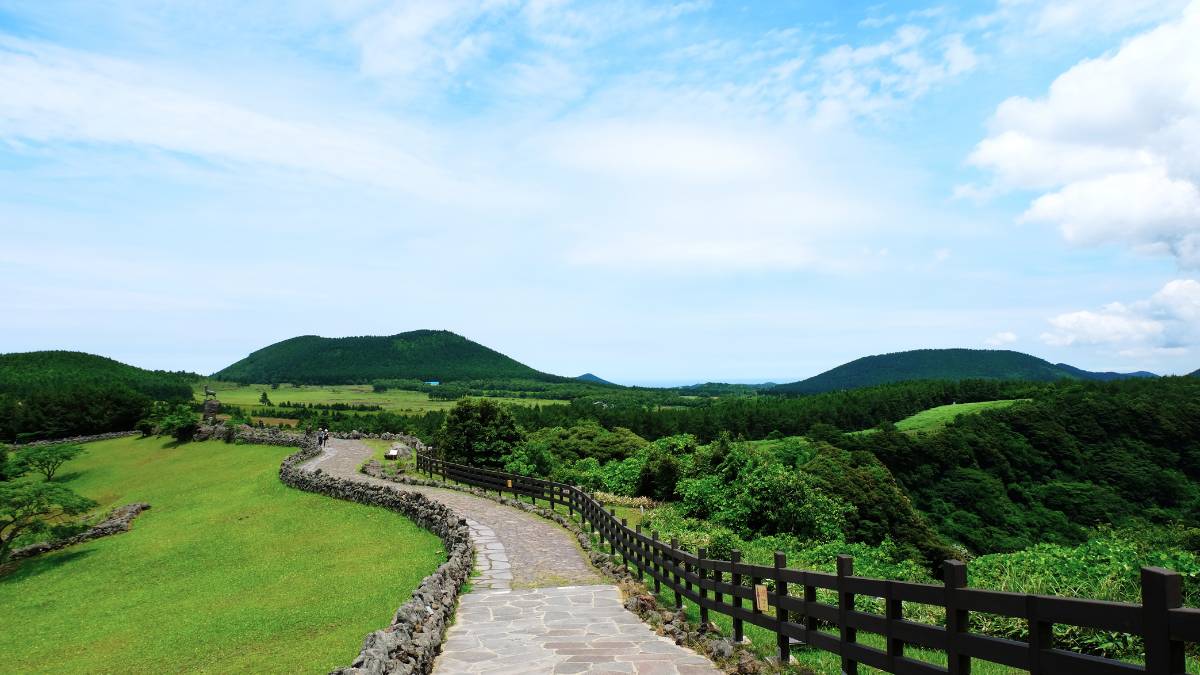
A beautiful natural monument, Sangumburi Crater is located in southeast Jeju Island.
It is 130 metres tall with an inner area of 300,000 square metres and an exterior circumference of 2,070 metres.
Sangumburi Crater is another testament to the number of extraordinary natural phenomena found in Jeju Island.
I particularly like the gentle uphill walk to Sangumburi Crater. The entire place is rich in natural beauty and is extremely well maintained.
The natural forest path that has been formed along with planted trees act as a beautiful gateway to the crater.
You will love your visit to Sangumburi Crater and experience a unique volcanic cone with lush forest all around.
15) Seongeup Folk Village
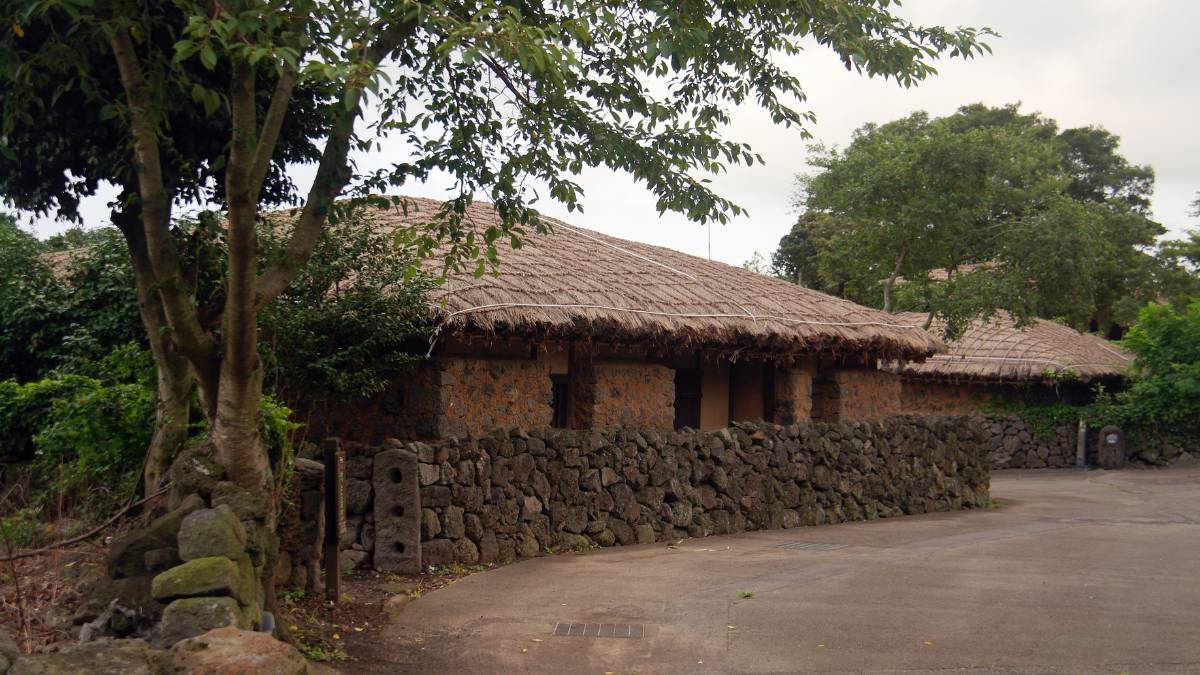
Located near the foothills of Mount Hallasan, Seongeup Folk Village is a well-preserved traditional village that you can visit.
Considering the focus of this list today is to experience the soul of Jeju Island, the village is a must-visit.
As mentioned already, Seongeup Folk Village is preserved to its original look and feel. That way tourists can get a glimpse into life in Jeju Island as it has been over the centuries.
Seongeup Folk Village is an idyllic, small village with homes built of lava rocks with thatched roofs.
Walking around the village really feels like a privilege as it is not your standard tourist attraction.
Do respect the locals and your surroundings when in Seongeup Folk Village as it is a real village. People still live in the houses that you see and their privacy must be respected.
Do note that often tourists get confused between Seongeup Folk Village and Jeju Folk Village.
The latter is a museum while Seongeup Folk Village is a real village in Jeju Island.
16) Jeju Museum Tour
Jeju Island is a museum lovers paradise.
There are 100 museums in Jeju Island. Each of them quite distinct from each other, providing a glimpse into the various facets of the island.
Now with 100 museums, it is not possible to cover them all during your short stay.
However, there are a few must-visit museums in Jeju Island as follows:
- Jeju National Museum
- O’sulloc Tea Museum
- Haenyeo Museum
- Jeju Folklore & Natural Museum
- Teddy Bear Museum
- Jeju Museum of War, History & Peace
- Alive Museum
Many of the museums showcase the culture, heritage, archaeology and history of Jeju Island.
However, there are some quirky ones as well that you will not come across anywhere else.
Depending upon your preference, enter the ones that appeal to you.
Do ask your sightseeing tour operator for which museums are included in their day tour.
17) Seogwipo Walking Tour
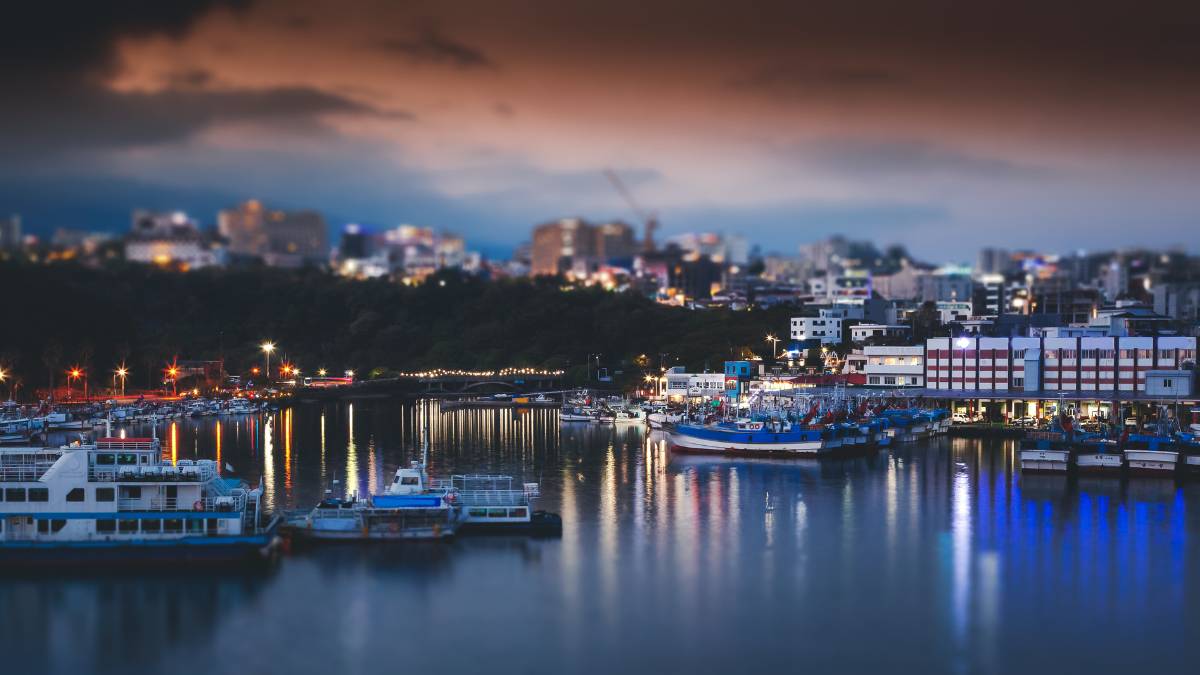
As mentioned earlier, there are only two main cities in Jeju Island.
Walking around both of these cities should be a must for all tourists.
Seogwipo Walking Tour is an ideal way to see the best of what this northern city has to offer.
The advantage of walking tours is that you get to experience a side of Seogwipo that is usually missed.
Walking tours in Seogwipo include not just the sights and sounds of the city, but also some incredible natural landmarks.
18) Jeju City Walking Tour
Jeju City is the capital of Jeju Island. It covers the northern region of the island.
Similar to what I mentioned about Seogwipo Walking Tour, you should walk around Jeju City as well.
What you will find interesting is that Jeju City is a modern city with strong connections to its past.
You can walk around Downtown Jeju or go towards the coastal walkways.
There are several trekking tours that start from Jeju City as well.
You will find incredible parks, museums and historical landmarks that you can visit while walking around Jeju City.
Don’t forget to enter restaurants to try out some local delicacies.
19) Learn about Haenyeo Divers
Haenyeo is an integral part of Jeju Island’s rich cultural heritage.
It refers to women divers who dive up to 10 metres under the sea to harvest a variety of marine life.
This includes sea urchins, seaweed, mollusks, shellfish, abalone and even pearls.
What is incredible is that no safety equipment is used and the women dive without any oxygen masks.
Many believe Haenyeo divers reflect the strong spirit of Jeju Island and these women are highly revered.
Most of the Haenyeo women divers are now above the age of 60 but still go diving as a choice.
Learning about Haenyeo women divers is an important aspect of experiencing the culture of Jeju Island.
To learn more, you can visit the Haenyeo museum or check out the Haenyeo show at Seongsang Ilchubong.
For something fun and different, you can even opt for a Haenyeo traditional clothes rental and photoshoot experience.
20) Hallim Park
Hallim Park is one of the best parks you will visit in entire Asia.
It has everything that you would want as a nature enthusiast.
You have breathtaking natural beauty, views of beaches and islands, two caves to explore, folk village, multiple gardens and more.
Tourists can easily spend a lot of time at Hallim Park and it is great for those traveling with kids.
There are several amenities and recreational facilities at the park for both adults and children.
Overall, there are several beautiful gardens and parks in Jeju Island.
Nevertheless, Hallim Park is one of the most popular ones for tourists and is often included in most day tours.
Bonus
The above 20 things to do are an absolute must in Jeju Island.
However, if you do have the time, here are couple of bonus activities that are equally thrilling.
1) Take a Ferry Trip to Udo Island
Udo Island is located at a 15-minute ferry ride from Jeju Island. The actual distance is about 3.5 kms towards the east from the main island.
Typically, visiting Udo Island is in itself a day tour.
Hence you need to do this if you have an extra day with you.
Udo Island is a small island of incredible beauty. It is shaped like a cow and hence its name Udo, which means ‘Cow Island’.
You can reach Udo Island by taking a ferry from Seongsan Port in Jeju Island.
2) Mysterious Road (Dokkaebi Road)
Mysterious Road or Dokkaebi Road is a fun and unique place in Jeju Island.
It is a road with a unique optical illusion. You may feel you are going uphill when the car is actually going backwards.
This mysterious road was discovered when travellers in a stationary car was surprised that it started moving uphill.
The reality was the car was actually moving back and needed to be stopped.
Since its discovery, many tourists prefer taking a taxi to the spot to experience the same.
Do note that the optical illusion is visible only at a certain point. Therefore, you will need an experienced driver who can locate the spot.
You may also like to read:
Why Jeju Island in South Korea is a true wonder of the world
Explore Jeju Island with these Incredible Hotels and Resorts
Final thoughts
Saying Jeju Island is unique is an understatement. It is a true natural wonder of the world with breathtaking beauty.
You must visit this incredible island located in the Korean Strait at least once in your lifetime.
When at the island, do experience it to the fullest and learn about Jeju Island’s beautiful culture and heritage.

